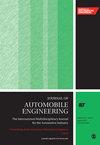Predictive method of pressure loss in wet clutch caused by seal wear based on stacking ensemble learning
IF 1.5
4区 工程技术
Q3 ENGINEERING, MECHANICAL
Proceedings of the Institution of Mechanical Engineers Part D-Journal of Automobile Engineering
Pub Date : 2024-04-26
DOI:10.1177/09544070241247369
引用次数: 0
Abstract
The harsh operating conditions of heavy-duty vehicles accelerates the wear of the sealing ring in the transmission, leading to increased oil leakage and a reduction of the operating pressure in the piston cylinder of wet clutch. This impairs the proper functioning of the transmission in the heavy-duty vehicle. Therefore, it is necessary to predict the pressure loss inside the transmission quickly and effectively after the wear of the sealing ring. The wear of the sealing ring under different operating conditions is calculated through the modified Archard model. The relationship between the oil leakage and pressure loss after the wear of the sealing ring is analyzed using Fluent software. The analysis involves the effects of different wear levels of the sealing ring. The simulation results are validated through a high-speed oil cylinder performance test rig. Based on the validated simulation data and test data, a prediction model for pressure loss is established by using stacking ensemble learning with MLR (multiple linear regression), DTR (decision tree regression), and SVR (support vector regression) as the base learners and RF (random forest) as the meta-learner. The risk of model overfitting is reduced through k-fold cross-validation. The research results indicate that the fused stacking ensemble learning algorithm fully utilizes the advantages of each base learner and can effectively predict the pressure loss after the wear of the sealing ring, and achieve a higher accuracy. The establishment of this model provides theoretical support for real-time prediction of pressure loss after the wear of the sealing ring in actual heavy-duty vehicles.基于堆叠集合学习的湿式离合器密封磨损导致压力损失的预测方法
重型车辆恶劣的工作条件加速了变速器密封环的磨损,导致漏油增加和湿式离合器活塞缸工作压力降低。这将影响重型车辆变速器的正常工作。因此,有必要快速有效地预测密封环磨损后变速器内部的压力损失。密封环在不同工作条件下的磨损是通过改进的 Archard 模型计算得出的。使用 Fluent 软件分析了密封环磨损后漏油和压力损失之间的关系。分析涉及密封环不同磨损程度的影响。模拟结果通过高速油缸性能试验台进行了验证。根据验证后的模拟数据和测试数据,以 MLR(多元线性回归)、DTR(决策树回归)和 SVR(支持向量回归)为基础学习器,以 RF(随机森林)为元学习器,通过堆叠集合学习建立了压力损失预测模型。通过 k 倍交叉验证降低了模型过拟合的风险。研究结果表明,融合堆叠集合学习算法充分发挥了各基础学习器的优势,能有效预测密封环磨损后的压力损失,并达到了较高的精度。该模型的建立为实时预测实际重型车辆密封环磨损后的压力损失提供了理论支持。
本文章由计算机程序翻译,如有差异,请以英文原文为准。
求助全文
约1分钟内获得全文
求助全文
来源期刊

CiteScore
4.40
自引率
17.60%
发文量
263
审稿时长
3.5 months
期刊介绍:
The Journal of Automobile Engineering is an established, high quality multi-disciplinary journal which publishes the very best peer-reviewed science and engineering in the field.
 求助内容:
求助内容: 应助结果提醒方式:
应助结果提醒方式:


